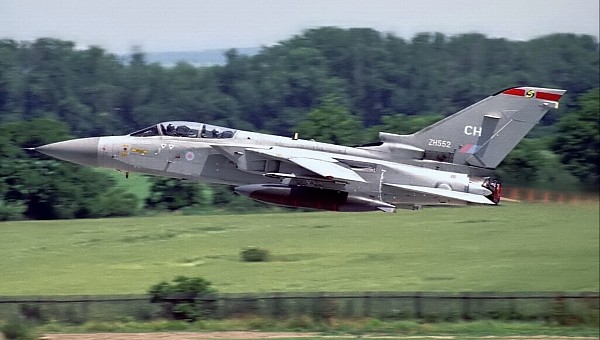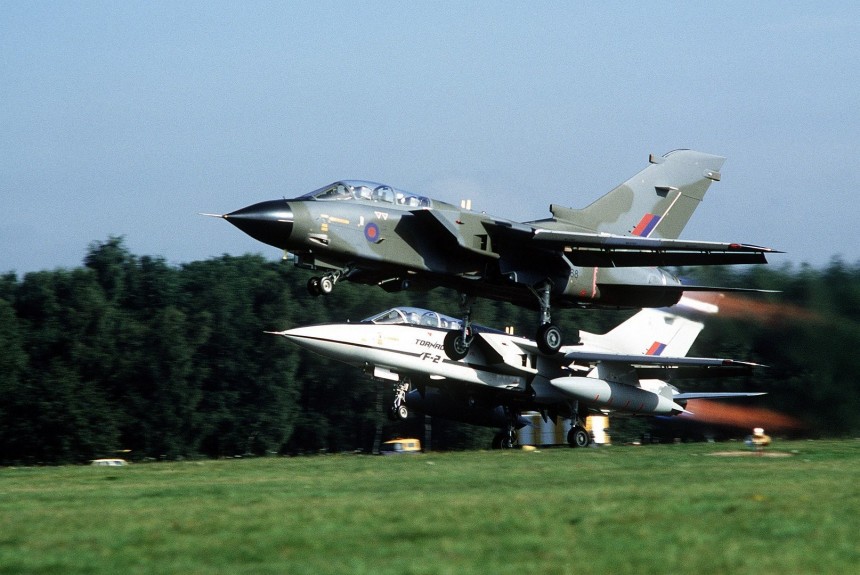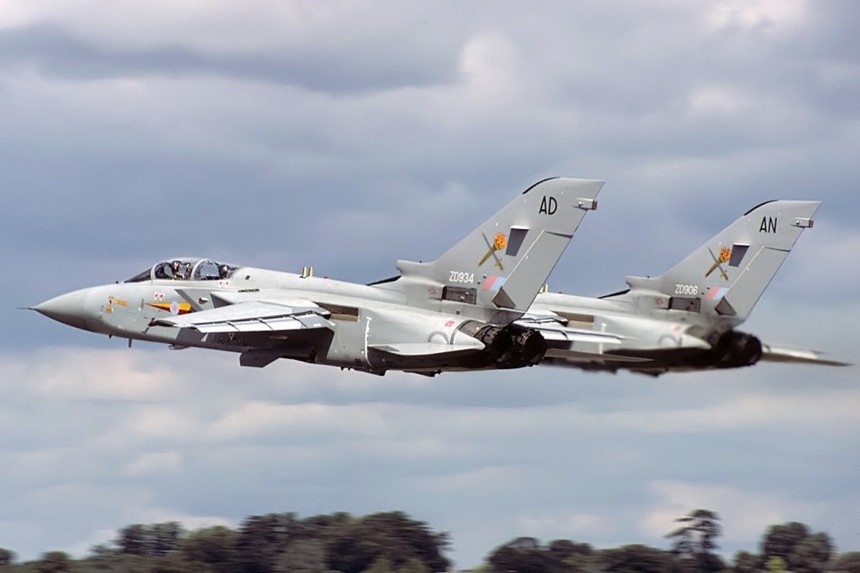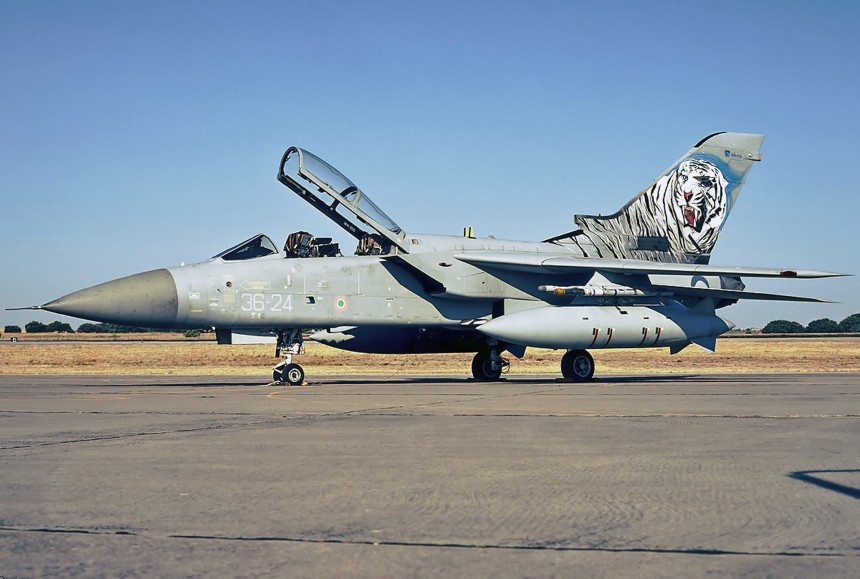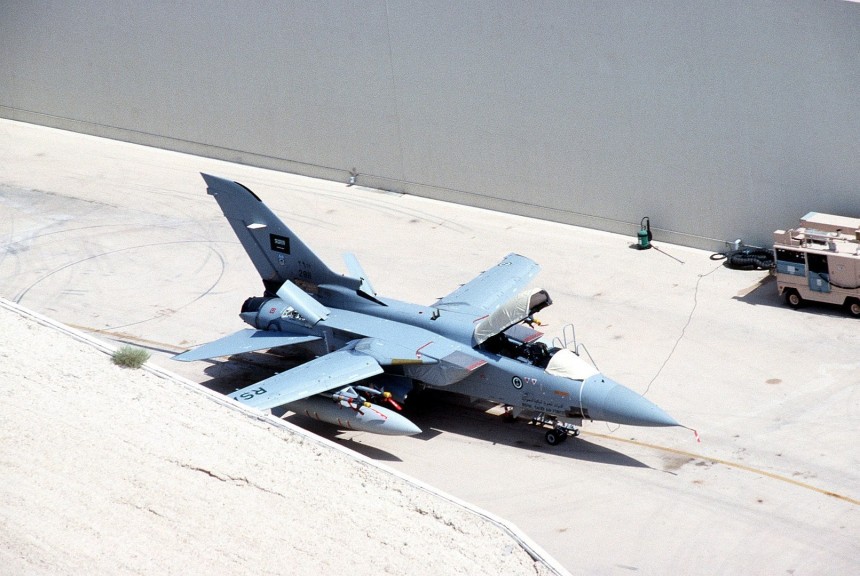The British were learning to contend with many things in the 1970s, apart from the obvious empire-falling-apart business. One of these things was learning to play nice with its European neighbors when building airplanes. Until the Eurofighter came around, perhaps the most fruitful pan-European effort to build a military jet was the Panavia Tornado. But it wasn't all smooth sailing.
As a jet solidly in the multi-role category with an emphasis on ground attack operations, one would think all parties involved would be content with a single design. But remember, Britain, Italy, and Germany had only stopped shooting at each other a generation or so before the Tornado first flew. This meant each respective nation wanted its variant with bespoke requirements.
To say this led to some classic British Aircraft Corporation hijinks would be an understatement. This is the story of the Tornado ADV, the swing-wing jet optimized for a ground attack that tried to be a high-altitude interceptor. Safe to say, things didn't go according to plans. Like an old-school Top Gear cheap car challenge, there was a fair amount of classic British improvisation on display.
The standard Panavia Tornado IDS (GR1) was a technological marvel when it first flew in 1974. As a large, two-seater swing-wing fighter bomber, the IDS served the same role the American F-111 Aardvark, and the Soviet MiG-27 did as a long-range interdictor and part-time close-up ground strike aircraft with variable-geometry wings and enough ordinance humble a battalion or two.
With two Turbo-Union RB-199 three-spool turbofan engines jetting 43.8 kN (9,800 lbf) of dry thrust, the Tornado IDS could fly at twice the speed of sound while being stable at slower speeds. This is all very important to accurately identify ground targets and blow them up. For this role, the Tornado's BAE Systems radar was optimized for its intended ground attack missions, with air-to-air combat being a far lower priority. In some regards, it was almost an afterthought.
So then, it'd appear at first glance that the Tornado is an awful platform to convert into an interceptor. You know, a jet intended to shoot down Soviet nuclear bombers flying across the North Sea, hell-bent on turning the U.K. into an uninhabitable irradiated wasteland. Then again, British aerospace engineers sometimes see things differently than the rest of us.
In truth, the impetus of the Tornado ADV's design wasn't the result of a drunken bet in a pub between two British engineers to see if they could pull off turning a ground attack jet into an interceptor. Rather, Royal Air Force's Air Staff Requirement 395 in the mid-1970s, called for a plan to replace the RAF's fleet of English Electric Lightnings and American F-4 Phantom IIs necessitated some form of novel replacement.
Even before the Tornado IDS first flew, the idea that the airframe could be optimized for high-altitude bomber interception was quietly studied by the British Aerospace Company's portion of Panavia's design team. In spite of protests from the German and Italian sides of the operation, the production of the Tornado Air Defense Variant (ADV) was announced on March 4th, 1976. It was to be an all-British affair, as Airbus and Leonardo S.p.A both wanted nothing to do with the project.
BAE touted the Tornado ADV as a low-cost solution to providing the RAF with an F-14 or F-15 equivalent without having to negotiate unfavorable contracts with American aerospace giants. The problem is, of course, it's a lot harder to swap a fighter bomber's internals for high-altitude bomber interception hardware than LS swapping your car.
With dimensions of 18.68 meters (61 ft 3 in) long with a 13.91-meter (45 ft 8 in) wingspan at 25 degrees of wing sweep, the Tornado ADS was actually slightly larger than the last British Tornado IDS variant produced, the GR4. The Tornado ADV's dimensions are within a few feet of the Grumman F-14 Tomcat, the U.S. Navy's respective answer to the swing-wing interceptor. Just in case you needed a reminder of how huge the two planes are.
The bulk of this extra size is down to the Tornado ADV's I.24 Foxhunter pulse-doppler radar optimized for medium to high altitude interception. Even compared to the F-14's Hughes AN/AWG-9 radar, this was a fairly robust and capable radar system by late 1970s standards. As for armament, no interceptor worth its salt flew without a cannon 40 years ago.
That's why ten hardpoints to mount AiM-9 Sidewinders, BAE Skyflashes, and AiM-120 AMRAAM air-to-air missiles are flanked by a single Mauser BK-27 27 mm revolver cannon with 180 rounds of ammo. With a top speed of Mach 2.2 (1,500 mph, 1,300 kn) and a combat range of 1,853 km (1,151 mi, 1,001 nmi) if flown below supersonic, the Tornado ADV lagged somewhat behind the F-14's top speed of Mach 2.34 (1,544 mph, 2,485 km/h), and ferry range of 2,960 km (1,840 mi, 1,600 nmi.).
Even so, there's no arguing having a high-altitude bomber interceptor is better than going without one. The first British variant of the Tornado ADV, dubbed the F2, was delivered to the RAF in November 1984. Panavia was forthcoming in explaining to the RAF that the Tornado F2 was an interim aircraft while the more capable Tornado F3 was under development. But by underdeveloped, we think they meant incomplete.
Why? Because the darn thing didn't have a radar. It turned out the Foxhunter radar purpose-built for the Tornado ADV had run into considerable design delays and production snafus. Not wanting to turn up to the RAF empty-handed, Panavia simply mounted a cured cement ballast to the nose section of the Tornado F2. Hilariously, RAF pilots and ground crews dubbed this ballast the "Blue Circle radar," inspired by a brand of British cement.
Most of the kinks in the Tornado F2's design were worked out by November 1985, the month the now-completed Tornado F3 first flew. Perhaps the most notable design upgrade of the F3 variant was the ability of the plane's autopilot to automatically adjust wing geometry in flight depending on the air speed. This feature was also a key feature of the F-14. Starting in the early 1990s, the Italian Air Force decided it needed more aircraft to bolster its fleet of then-brand-new Eurofighter Typhoons.
The first Italian pilots were trained on Tornado F3 systems at RAF Coningsby in Lincolnshire, England starting in 1995. Compared to how hesitant the other two-thirds of Panavia were to be involved with the ADV program in the beginning, this change of heart is nothing short of bizarre. Even Saudi Arabia signed a contract to procure 42 Tornado ADVs in 1985.
The Royal Saudi Arabian Air Force promptly found the aircraft to be insufficient for their needs and ordered American F-15E Strike Eagles soon afterward. From the Persian Gulf to Yugoslavia, Iraq, and Afghanistan, the Tornado served wherever the RAF waged war from its debut in 1985 until the last three Tornado F3s were flown to the RAF base at Leeming, North Yorkshire, for scrapping in 2012.
Though the Tornado F2 was something of a laughable airplane, it's hard to call the full-fledged Tornado F3 a failure. But it begs the question, how many F-14 Tomcats could the RAF have acquired had they not spent billions modifying a multi-role jet to shoot down bombers? For that and so many other reasons, the Tornado ADV will forever live in the shadow of not only the Tomcat but also the Tornado IDS the thing was derived from in the first place.
But then again, the Tomcat isn't in service with the U.S. anymore, either. It's possible that while variable geometry wings are cool as heck, they simply aren't worth the development and maintenance hassle they present to Air Force ground crews. What this means is that one day, swing-wing jets will likely be a total thing of the past. If you ask us, that's a bit sad.
To say this led to some classic British Aircraft Corporation hijinks would be an understatement. This is the story of the Tornado ADV, the swing-wing jet optimized for a ground attack that tried to be a high-altitude interceptor. Safe to say, things didn't go according to plans. Like an old-school Top Gear cheap car challenge, there was a fair amount of classic British improvisation on display.
The standard Panavia Tornado IDS (GR1) was a technological marvel when it first flew in 1974. As a large, two-seater swing-wing fighter bomber, the IDS served the same role the American F-111 Aardvark, and the Soviet MiG-27 did as a long-range interdictor and part-time close-up ground strike aircraft with variable-geometry wings and enough ordinance humble a battalion or two.
With two Turbo-Union RB-199 three-spool turbofan engines jetting 43.8 kN (9,800 lbf) of dry thrust, the Tornado IDS could fly at twice the speed of sound while being stable at slower speeds. This is all very important to accurately identify ground targets and blow them up. For this role, the Tornado's BAE Systems radar was optimized for its intended ground attack missions, with air-to-air combat being a far lower priority. In some regards, it was almost an afterthought.
In truth, the impetus of the Tornado ADV's design wasn't the result of a drunken bet in a pub between two British engineers to see if they could pull off turning a ground attack jet into an interceptor. Rather, Royal Air Force's Air Staff Requirement 395 in the mid-1970s, called for a plan to replace the RAF's fleet of English Electric Lightnings and American F-4 Phantom IIs necessitated some form of novel replacement.
Even before the Tornado IDS first flew, the idea that the airframe could be optimized for high-altitude bomber interception was quietly studied by the British Aerospace Company's portion of Panavia's design team. In spite of protests from the German and Italian sides of the operation, the production of the Tornado Air Defense Variant (ADV) was announced on March 4th, 1976. It was to be an all-British affair, as Airbus and Leonardo S.p.A both wanted nothing to do with the project.
BAE touted the Tornado ADV as a low-cost solution to providing the RAF with an F-14 or F-15 equivalent without having to negotiate unfavorable contracts with American aerospace giants. The problem is, of course, it's a lot harder to swap a fighter bomber's internals for high-altitude bomber interception hardware than LS swapping your car.
The bulk of this extra size is down to the Tornado ADV's I.24 Foxhunter pulse-doppler radar optimized for medium to high altitude interception. Even compared to the F-14's Hughes AN/AWG-9 radar, this was a fairly robust and capable radar system by late 1970s standards. As for armament, no interceptor worth its salt flew without a cannon 40 years ago.
That's why ten hardpoints to mount AiM-9 Sidewinders, BAE Skyflashes, and AiM-120 AMRAAM air-to-air missiles are flanked by a single Mauser BK-27 27 mm revolver cannon with 180 rounds of ammo. With a top speed of Mach 2.2 (1,500 mph, 1,300 kn) and a combat range of 1,853 km (1,151 mi, 1,001 nmi) if flown below supersonic, the Tornado ADV lagged somewhat behind the F-14's top speed of Mach 2.34 (1,544 mph, 2,485 km/h), and ferry range of 2,960 km (1,840 mi, 1,600 nmi.).
Even so, there's no arguing having a high-altitude bomber interceptor is better than going without one. The first British variant of the Tornado ADV, dubbed the F2, was delivered to the RAF in November 1984. Panavia was forthcoming in explaining to the RAF that the Tornado F2 was an interim aircraft while the more capable Tornado F3 was under development. But by underdeveloped, we think they meant incomplete.
Most of the kinks in the Tornado F2's design were worked out by November 1985, the month the now-completed Tornado F3 first flew. Perhaps the most notable design upgrade of the F3 variant was the ability of the plane's autopilot to automatically adjust wing geometry in flight depending on the air speed. This feature was also a key feature of the F-14. Starting in the early 1990s, the Italian Air Force decided it needed more aircraft to bolster its fleet of then-brand-new Eurofighter Typhoons.
The first Italian pilots were trained on Tornado F3 systems at RAF Coningsby in Lincolnshire, England starting in 1995. Compared to how hesitant the other two-thirds of Panavia were to be involved with the ADV program in the beginning, this change of heart is nothing short of bizarre. Even Saudi Arabia signed a contract to procure 42 Tornado ADVs in 1985.
The Royal Saudi Arabian Air Force promptly found the aircraft to be insufficient for their needs and ordered American F-15E Strike Eagles soon afterward. From the Persian Gulf to Yugoslavia, Iraq, and Afghanistan, the Tornado served wherever the RAF waged war from its debut in 1985 until the last three Tornado F3s were flown to the RAF base at Leeming, North Yorkshire, for scrapping in 2012.
But then again, the Tomcat isn't in service with the U.S. anymore, either. It's possible that while variable geometry wings are cool as heck, they simply aren't worth the development and maintenance hassle they present to Air Force ground crews. What this means is that one day, swing-wing jets will likely be a total thing of the past. If you ask us, that's a bit sad.
